Final answer to the problem
Step-by-step Solution
How should I solve this problem?
- Choose an option
- Integrate by partial fractions
- Integrate by substitution
- Integrate by parts
- Integrate using tabular integration
- Integrate by trigonometric substitution
- Weierstrass Substitution
- Integrate using trigonometric identities
- Integrate using basic integrals
- Product of Binomials with Common Term
- Load more...
Apply properties of logarithms to expand and simplify the logarithmic expression $\ln\left(e^{-11y}\right)$ inside the integral
Learn how to solve definite integrals problems step by step online.
$\int-11ydy$
Learn how to solve definite integrals problems step by step online. Solve the integral of logarithmic functions int(ln(e^(-11y)))dy. Apply properties of logarithms to expand and simplify the logarithmic expression \ln\left(e^{-11y}\right) inside the integral. The integral of a function times a constant (-11) is equal to the constant times the integral of the function. Applying the power rule for integration, \displaystyle\int x^n dx=\frac{x^{n+1}}{n+1}, where n represents a number or constant function, in this case n=1. Multiply the fraction and term in -11\cdot \left(\frac{1}{2}\right)y^2.
